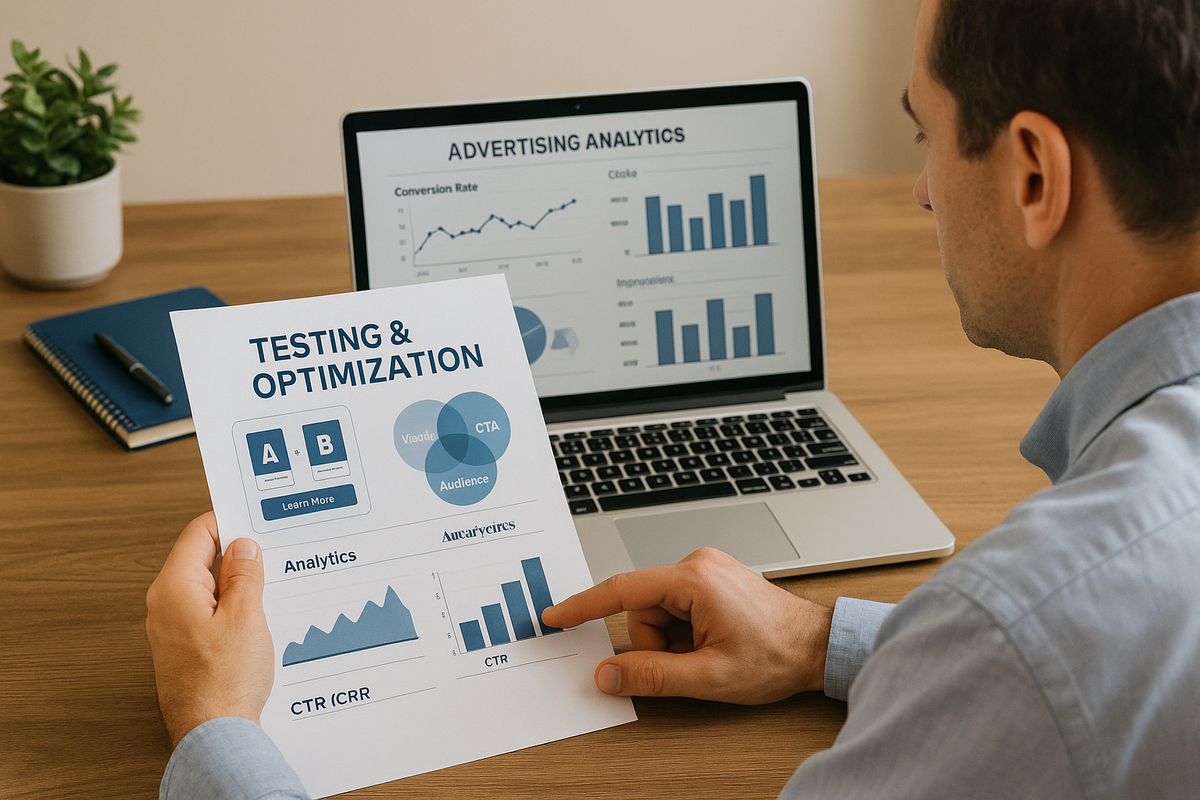
By Jenny Holly Hansen | WBN News | May 8, 2025
In the world of advertising, guessing is no longer an option. To connect with your audience effectively, you need to know what works and why. Testing and optimizing your advertising campaigns allow you to discover what resonates with your audience and refine your approach constantly. With analytics at the heart of this process, you can turn data into actionable insights and maximize the impact of your efforts.
Here’s how to implement a strategy of testing, optimization, and analytics to create more effective advertising campaigns.
The Importance of Testing and Optimization in Advertising
Every audience is unique, and what works for one segment or platform might not work for another. Testing and optimization:
- Maximize ROI: By focusing on high-performing elements, you can reduce waste and increase returns.
- Enhance Relevance: Tailoring your ads based on insights ensures they resonate with your target audience.
- Improve Engagement: Refining your approach increases click-through rates (CTR), conversions, and other engagement metrics.
- Stay Competitive: Continuously optimizing ensures your campaigns evolve alongside audience preferences and market trends.
Steps to Test and Optimize Your Advertising Campaigns
1. Set Clear Goals
Before you begin testing, define what you want to achieve. Common goals include:
- Increasing website traffic.
- Boosting conversions or sales.
- Enhancing brand awareness.
- Improving engagement metrics like CTR or video views.
Having clear objectives ensures you measure the right metrics and stay focused on meaningful outcomes.
2. Identify Variables to Test
Testing involves experimenting with different elements of your ad to determine what works best. Common variables include:
- Headlines: Test different headlines to see which grabs attention.
- Visuals: Compare images, videos, or graphic designs.
- Call-to-Action (CTA): Experiment with CTAs like “Learn More” vs. “Shop Now.”
- Ad Copy: Test tone, length, and messaging.
- Target Audience: Refine demographics, interests, or behaviors.
- Platforms: Compare performance across social media, search engines, or display networks.
3. Conduct A/B Testing
A/B testing, also known as split testing, is one of the most effective ways to refine your campaigns. It involves running two versions of an ad with a single variable changed to see which performs better.
- Example: A clothing retailer tests two versions of an ad—one with a 20% discount and another with “Free Shipping” as the offer. The results reveal which incentive drives more conversions.
4. Use Multivariate Testing
For more complex campaigns, multivariate testing examines multiple variables simultaneously. This approach helps identify combinations of elements that perform best.
- Example: A travel agency tests different headlines, images, and CTAs together to find the most effective combination.
5. Monitor Analytics Regularly
Analytics tools are essential for tracking performance and identifying trends. Key metrics to monitor include:
- Impressions and Reach: How many people see your ad.
- Click-Through Rate (CTR): The percentage of people who click on your ad after seeing it.
- Conversion Rate: The percentage of users who take the desired action.
- Cost-Per-Click (CPC): How much you pay for each click.
- Bounce Rate: The percentage of users who leave your landing page without engaging further.
Use tools like Google Analytics, Facebook Insights, or your ad platform’s dashboard to gather insights.
6. Analyze Results and Make Data-Driven Decisions
Once you’ve collected data, analyze it to identify what’s working and what isn’t. Look for patterns, such as:
- Which headlines generate the highest CTR.
- Which visuals drive the most engagement.
- Which audiences respond best to your ads.
Use these insights to refine your campaigns.
- Example: A fitness app discovers that ads featuring testimonials perform better than those highlighting product features. Future campaigns focus on user stories.
7. Iterate and Optimize
Testing and optimization are not one-time tasks—they’re ongoing processes. Continuously refine your approach based on new data and audience behavior.
- Example: A software company runs monthly A/B tests on its landing pages, optimizing headlines, visuals, and CTAs to improve conversion rates over time.
Best Practices for Testing and Optimization
- Start Small: Test one or two variables at a time to maintain clarity and avoid overwhelming data.
- Be Patient: Allow enough time for your tests to collect meaningful data before drawing conclusions.
- Test Across Platforms: Audiences behave differently on Instagram, Facebook, Google, and LinkedIn. Test and optimize for each platform.
- Document Results: Keep records of your tests, results, and optimizations to inform future campaigns.
- Embrace Failure: Not every test will succeed, but every result provides valuable insights.
Tools for Testing and Optimization
- Google Analytics: Tracks website traffic, user behavior, and conversion paths.
- Facebook Ads Manager: Offers A/B testing and detailed audience insights.
- HubSpot: Provides tools for testing email campaigns and landing pages.
- Optimizely: Specializes in multivariate testing and optimization.
- SEMrush: Analyzes ad performance and keyword effectiveness.
The Benefits of Testing and Optimization
- Enhanced Engagement: Deliver content that truly resonates with your audience.
- Increased Efficiency: Focus your budget on high-performing elements and reduce waste.
- Improved ROI: Achieve better results without increasing your ad spend.
- Audience Insights: Gain a deeper understanding of your audience’s preferences and behaviors.
- Future-Ready Campaigns: Continuously evolve your strategy to stay ahead of trends.
Conclusion: The Art of Refinement
Effective advertising is an ongoing process of discovery, refinement, and improvement. By testing and optimizing your campaigns and leveraging analytics to guide your decisions, you can ensure your ads resonate with your audience, achieve your goals, and deliver meaningful results.
In the ever-changing world of advertising, adaptability is your greatest strength. Embrace the power of data and commit to continuous improvement—because the better you know your audience, the better you can connect with them.
Let’s Keep Talking:
Jenny is a business insurance broker with Waypoint Insurance.
She can be reached at 604-317-6755 or jhansen@waypoint.ca. Connect with Jenny on LinkedIn at https://www.linkedin.com/in/jenny-holly-hansen-365b691b/. Connect with Jenny at BlueSky: https://bsky.app/profile/jennyhollyhansen.bsky.social
Let’s Meet Up:
Jenny Holly Hansen is a cohost with Chris Sturges of the Langley Impact Networking Group. You are welcome to join us on Thursday’s from 4pm to 6pm at: Sidebar Bar and Grill: 100b - 20018 83A Avenue, Langley, BC V2Y 3R4
TAGS: #Jenny Holly Hansen #Advertising #Data Analytics #Variables



